How To Buy Diamonds- A Comprehensive Guide
June 12, 2013
— art and decors, Art and Decors Jewelr, Business, Carat, Diamond, Diamond clarity, Diamond cut, Diamond Jewelry, Four C, Jewelry, Light
Diamonds are a women’s best friend! But do you know what is the correct way to choose the right Diamond? Well don’t worry because we got your back. Or your heart! 🙂 So read on….
The 4 C’s to look out for while choosing the right Diamond:
- Cut
- Clarity
- Colour
- Carat Weight
Each of the Four Cs describes a diamond’s specific characteristic.
CUT:
The beauty of a diamond depends more on cut than any other of the four Cs for us to understand.
Cut refers to the proportions, polish, and symmetry of a stone: these three factors are important in creating a diamond with the best possible light reflection. The angles and finish of any diamond are what determine its ability to handle light, and its brilliance.
What to look for?
When choosing a diamond, hold it up to the light and look at the way the light dances around – it should throw out a rainbow of colours and display the diamond’s natural brilliance. Look at many different cuts and shapes so you can try on a good selection to find the perfect one for you.
Cut also refers to the shape of the diamond. Round, princess, oval, square, marquise, pear, emerald, or cushion-shaped are some of the most familiar, but advancing technology continues to offer a larger variety of shapes and cuts to choose from.
CLARITY:
Clarity, or purity, is a diamond’s ability to let in light and reflect its brilliance. We measure the clarity of a diamond by its size and the number of inclusions and blemishes in or on it.
Inclusions are interior irregularities such as air bubbles, cracks, and non-diamond minerals found within the diamond, which are caused deep within the earth during its formation.
Blemishes are exterior irregularities or imperfections on a diamond’s exterior surface and include scratches, pits and chips.
The internationally accepted system of grading divides clarity into five distinct groups:
- Flawless (FL) diamonds are those with no internal features and no external features or blemishes visible at 10 x magnification. An Internally Flawless (IF) diamond will also have no internal features, but may exhibit a minute scratch left over from polishing.
- Very Very Slightly (VVS) included diamonds are those with minute inclusions so small that they are extremely difficult for even a skilled diamond grader to see at 10X magnification.
- Very Slightly (VS) Included are those diamonds with minor internal features deemed difficult for a skilled grader to detect at 10X.
- Slightly Included (SI) diamonds are those with internal features that are easily seen by the skilled grader at 10X magnification. Divided into SI1 and SI2, even an SI2 diamond may contain internal features that are still not visible to the unaided eye.
- Included (I-1, I-2, I-3) diamonds are those with features that are obvious at 10x magnification, can be visible to the unaided eye and may even affect the durability of the diamond.
What to look for?
View and try on diamonds of different clarities. In some diamonds, the internal features may be hidden by the setting and will not detract from a diamond’s overall beauty.
COLOUR:
When we speak of Colour in a diamond, we actually mean the degree of colourlessness. While most diamonds are white, not all are truly colourless. Many are tinted yellow to brown or silver to grey.
Diamonds are graded on a Whiteness scale or absence of colour scale. Basically, the whiter or clearer the colour of a diamond the greater its value.
As diamond size increases, colour becomes more noticeable. This is especially important to keep in mind if purchasing a diamond of two carats or greater.
What to look for?
- When buying a diamond, consider the setting and the metal, as it can be used to accentuate or de-emphasise the colour.
- Make sure you try on the diamond jewellery as the colour may look different when worn.
- If purchasing a loose diamond, carefully place the diamond on the top of your hand and compare it with a similar diamond mounted in jewellery.
CARAT WEIGHT:
A carat is the unit of weight by which a gemstone is measured. The carat-weight of a diamond is the easiest measurement of the 4C’s to determine. Carat-weight is not a factor which denotes the quality of a diamond, but merely its size by weight.
“Carat” is not to be confused with “karat,” which is used to indicate the purity of gold.
One carat is subdivided into 100 “points”. Therefore a diamond measuring 75 points is 3/4 carat in weight, or 0.75ct. There are five carats in a gram.
NOTE: Carat is abbreviated to “ct” or “CT” when describing a single stone. “TCW,” meaning “total carat weight,” is added when jewellery is set with multiple diamonds.
It has to be noted that the carat weight does not refer to exactly one figure. It comprises of stones within a certain weight range. For example:
1 carat – Stones in weight range of 0.95 ct to 1.05 ct
0.75 carat – Stones in weight range of 0.72 ct to 0.76 ct
0.50 carat – Stones in weight range of 0.47 ct to 0.56 ct
0.25 carat – Stones in weight range of 0.23 ct to 0.26 ct
This holds true for all carat weight figures.
What Carat Weight is right for me?
This question has no direct answer. It really depends. Differences in size are clearly visible even to the untrained eye, and weight clearly does matter because it influences cost significantly.
However, size alone does not guarantee beauty. The quality of a diamond in cut, grade, and diameter should also be considered.
In deciding the importance of carat weight, it is vital to take into account the recipient’s preferences. If the dream is a one carat diamond, even the most beautiful half carat stone will be a disappointment. If a large carat weight is an important factor, but there is a strict budget, consider a diamond with a good cut, SI1-SI2 clarity, and an I or J colour grade. This will make room for a higher carat weight.
If quality is the primary factor, once the cut, colour, and clarity grade have been selected, it is easy to determine the carat-weight of the diamond that will fit within your budget.
If you like this, then please do share with your friends and family.
We would also to have you connect with us for more tips and inspirations on our Facebook and Pinterest page:
- Facebook: Art and Decors
- Pinterest: Art and Decors
And do visit our Jewelry section if you want to buy designer diamond, gold and fashion jewelry and shipped all over the world! To browse, click here: Gorgeous Jewelry For You




